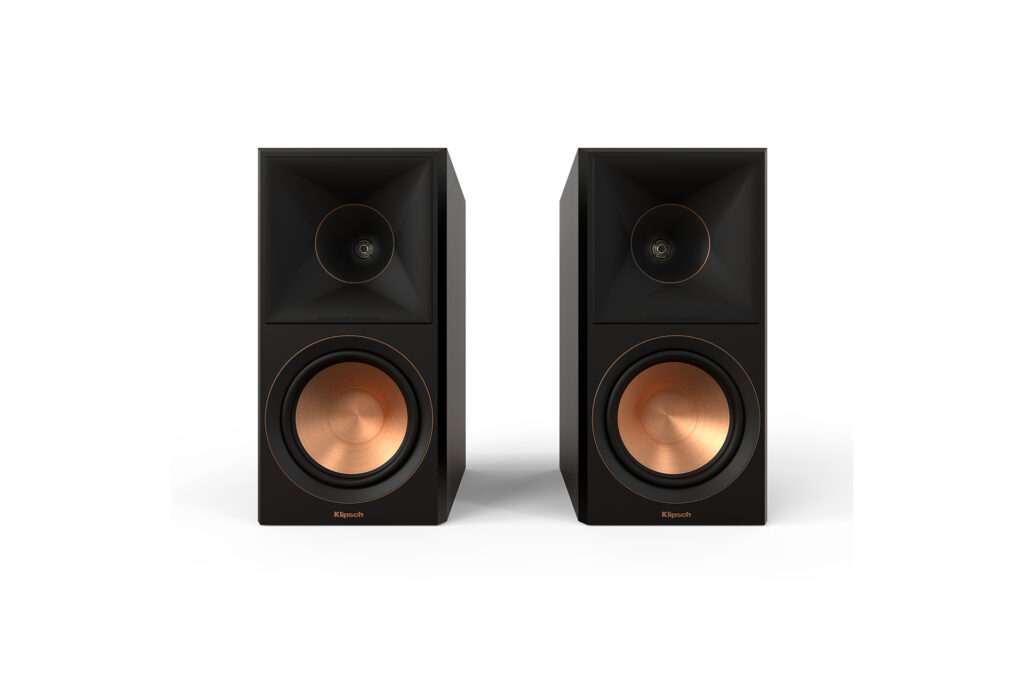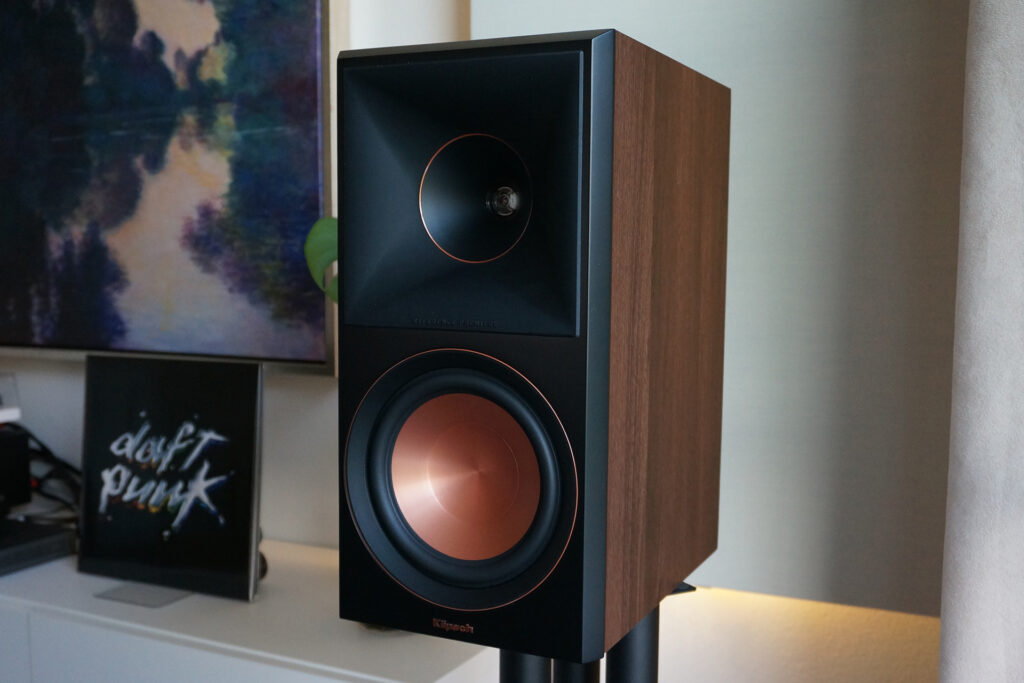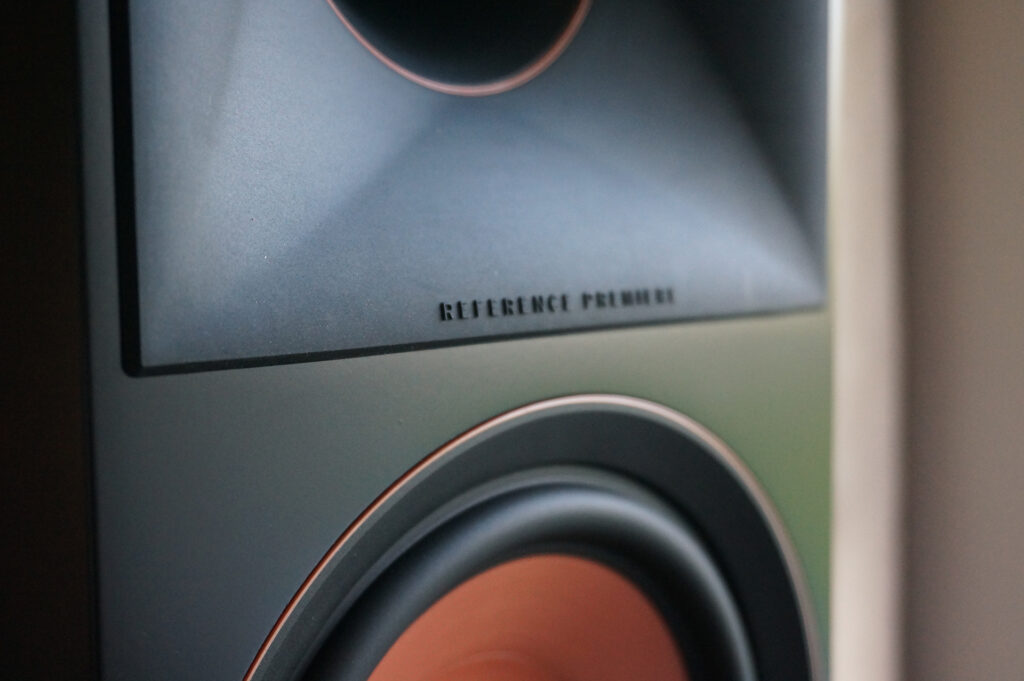When discussing iconic American speaker brands, Klipsch stands tall with its distinctive design philosophy and instantly recognizable aesthetic. The Klipsch Reference Premiere series has long been the sweet spot in their lineup, offering much of the company’s celebrated technology and sound signature at accessible price points. The Klipsch RP-600M II, the latest iteration of their mid-sized bookshelf speaker, builds upon the success of its predecessor while refining key aspects of performance.
Klipsch has made meaningful upgrades to the already impressive RP-600M, delivering improved detail retrieval and a more balanced presentation. We’re looking at a serious speaker that honors the company’s heritage while embracing modern refinements, all for $699 per pair. If your audiophile sensibilities gravitate toward dynamic, engaging sound and distinctive design, the RP-600M II demands a spot on your audition list.

What Makes the Klipsch RP-600M II Bookshelf Speaker Special?
- The iconic Tractrix horn-loaded tweeter is the crown jewel of Klipsch’s design philosophy.This signature one-inch titanium LTS (Linear Travel Suspension) dome tweeter, coupled with the proprietary 90° x 90° square Tractrix horn, represents the culmination of decades of refinement. The horn acts as an acoustic amplifier, dramatically increasing efficiency while controlling the high-frequency dispersion. For the RP-600M II, Klipsch has further refined the horn geometry, resulting in a smoother transition between the tweeter and horn for reduced distortion. The vented design of the tweeter housing reduces standing waves behind the diaphragm, delivering cleaner, more detailed high frequencies that reveal subtle nuances in your favorite recordings without fatigue.
- The 6.5-inch Cerametallic woofer continues Klipsch’s tradition of high-efficiency driver design. This distinctive copper-colored cone isn’t just about aesthetics – it’s formed from an aluminum substrate with a ceramic coating applied to both sides, creating an exceptionally rigid yet lightweight diaphragm. This construction provides superior pistonic movement, meaning the cone moves uniformly without unwanted flexing, resulting in reduced distortion and improved transient response. The striking copper color isn’t just for show; it’s a visual signature of Klipsch’s commitment to materials that perform as good as they look.
- Unlike many competitors that employ simple ported designs, the RP-600M II features Klipsch’s proprietary Tractrix port technology. Located on the rear of the cabinet, this uniquely shaped port minimizes air turbulence and port noise, even during demanding bass passages. The geometry of the Tractrix horn-shaped port ensures smooth airflow, reducing the “chuffing” sounds common in lesser designs. This allows the speaker to deliver deeper, cleaner bass from a modestly-sized enclosure, providing a foundation that belies the speaker’s compact dimensions.
- The crossover network in the Klipsch RP-600M II has been completely redesigned from its predecessor. Using higher-quality components and a refined topology, the new crossover achieves a more seamless integration between the horn-loaded tweeter and woofer. This invisible but crucial improvement minimizes phase issues and creates a more cohesive soundstage. The higher-grade capacitors and air-core inductors in the signal path ensure that nothing is lost between your amplifier and the drivers, preserving the integrity of your music and allowing you to hear exactly what the artists intended.
- The RP-600M II boasts a cabinet design that merges classic Klipsch aesthetics with modern refinements. Available in two premium finishes – Ebony and Walnut – these speakers command attention in any room. The furniture-grade wood veneer options (Ebony and Walnut) showcase beautiful grain patterns. The signature copper accents of the woofer and the horn’s outer trim provide a striking visual counterpoint to the cabinet. Klipsch has enhanced the speakers’ appearance with a cast polymer (composite) baffle that eliminates visible fasteners, creating a cleaner, more sophisticated look. The magnetically attached grilles allow you to choose between showcasing the distinctive drivers or adopting a more subdued appearance to match your decor. Either way, these speakers make a bold yet elegant statement that’s unmistakably Klipsch.

Why Should You Care About the Klipsch RP-600M II Bookshelf Speaker?
The Klipsch RP-600M II represents a compelling option for music enthusiasts across a broad spectrum of preferences and experience levels. For established audiophiles who appreciate the thrill and engagement of live music, the RP-600M II delivers that unmistakable Klipsch ability to recreate the dynamic impact and presence of a concert experience. The speakers’ exceptional efficiency and dynamic range allow them to capture both the delicate details and the powerful crescendos in music with a liveliness that many competitors simply cannot match.
For those new to high-performance audio, the Klipsch RP-600M II offers a particularly attractive entry point. Their high sensitivity rating of 94.5 dB @ 2.83V/1m means they’ll perform admirably, even with modest amplification, eliminating the need for expensive, high-powered amplifiers. This accessibility makes them an ideal foundation for a first serious stereo system. Moreover, their visually distinctive design – with the copper-colored drivers and horn-loaded tweeter – provides the satisfaction of owning speakers that not only sound exceptional but also make a confident aesthetic statement that will invite conversation.

Some Things You Might Not Like About Klipsch RP-600M II Bookshelf Loudspeaker
- While the RP-600M II represents a significant refinement over previous Klipsch models in terms of treble smoothness, some listeners may still find the high-frequency presentation more forward than other designs. Klipsch has deliberately voiced these speakers to provide detail and clarity that makes recordings come alive, but this characteristic might not appeal to those who prefer a more laid-back, relaxed high-frequency presentation. Particularly with poorly recorded or overly bright material, the revealing nature of the horn-loaded tweeter will not mask these flaws. To fully appreciate the Klipsch RP-600M II’s capabilities and mitigate potential brightness, careful system matching with electronics that have a neutral to slightly warm character is recommended.
- Despite improvements in the port design, the rear-firing Tractrix port means that placement relative to walls will significantly impact bass performance. While this is true of most ported speakers, the Klipsch RP-600M II is particularly sensitive to proper positioning. Placing them too close to a wall might result in boomy, exaggerated bass, while putting them too far into the room could lead to bass that feels lean. Finding the optimal placement may require more experimentation, compared to front-ported or sealed designs. For those with limited flexibility in speaker positioning, this characteristic could present a challenge in achieving the balanced sound these speakers are capable of delivering.
Listening to the Klipsch RP-600M II Bookshelf Speakers …
To evaluate the Klipsch RP-600M II’s performance, I integrated them into my reference system consisting of a Yamaha A-S301 integrated amplifier and Topping E30 DAC, streaming from Roon on a laptop. My listening room has GIK Acoustic panels at the first reflection points, providing controlled acoustics that allow speakers to perform at their best. I positioned the RP-600M IIs on solid stands about two-and-a-half feet from the back wall and seven feet apart, with a slight toe-in toward the listening position.
These speakers deliver an impressive frequency response of 44Hz-25kHz, providing remarkable extension for a bookshelf design. During my listening sessions, I was consistently impressed by both their bass capabilities and their refined high-frequency extension.
I began my critical listening with an acoustic recording I’ve long admired, “The Girl from Ipanema” by Stan Getz and João Gilberto. The Klipsch RP-600M IIs immediately showcased their ability to capture the breathy intimacy of Getz’s saxophone with remarkable presence. The horn-loaded tweeter revealed the subtle nuances of his embouchure and breathing techniques with exceptional clarity. Astrud Gilberto’s vocals floated between the speakers with a palpable three-dimensionality, creating the impression she was performing in my room. The speakers preserved the delicate percussion elements with precision, placing each instrument in a well-defined spatial location. The natural resonance of the acoustic bass came through with surprising weight and definition for speakers of this size, demonstrating the effectiveness of Klipsch’s bass-reflex design.
For something more dynamic, I turned to “Kashmir” by Led Zeppelin. Here, the Klipsch RP-600M IIs truly flexed their muscles. The explosive dynamics of John Bonham’s drumming burst forth with startling impact, showcasing the Klipschs’ ability to handle transients with speed and authority. The speakers maintained their composure even at higher volumes, delivering the complex layers of Jimmy Page’s guitar work and John Paul Jones’ orchestration without compression or strain. Robert Plant’s powerful vocals cut through the dense mix with clarity, maintaining the emotional intensity of his performance. The speakers’ ability to preserve both the macro-dynamics of the track’s crescendos and the micro-details of the string arrangements demonstrated their versatility with rock material.
For exploring the speakers’ ability to reproduce vocals, I selected “Landslide” by Fleetwood Mac. Stevie Nicks’ distinctive voice was rendered with exceptional transparency, revealing the emotional nuances of her performance. The delicate fingerpicked guitar work was presented with excellent resolution, each note possessing natural decay and harmonics. The Klipsch RP-600M IIs created a soundstage that extended beyond the speaker boundaries, placing Nicks’ voice slightly forward of the instruments – exactly as it should be. The midrange performance here was particularly impressive, striking a balance between detail and warmth that served the emotional content of the music.
To assess the speakers’ handling of complex orchestral works, I played Mahler’s Symphony No. 2 “Resurrection,” conducted by Leonard Bernstein. The RP-600M IIs demonstrated remarkable skill in preserving the layering of the orchestra, allowing me to follow individual instrumental lines even during dense passages. The dynamic range capabilities were on full display, effortlessly transitioning from the quietest string passages to the thunderous climaxes. While no bookshelf speaker can fully reproduce the scale and weight of a full orchestra, the Klipsch speakers conveyed an impressive sense of power and majesty. The horn-loaded tweeter’s efficiency and clarity particularly benefited the brass instruments, rendering them with appropriate bite and brilliance without becoming harsh.
Will the Klipsch RP-600M II Bookshelf Speakers Hold Their Value?
Klipsch speakers have historically maintained strong value retention in the secondary market, and the RP-600M II appears poised to continue this tradition. Several factors contribute to this desirable characteristic. First, Klipsch enjoys strong brand recognition and loyalty, with enthusiasts specifically seeking out their distinctive sound signature and aesthetic. The company’s long history and established reputation for build quality create confidence among potential buyers, even in the used market.
What is the Competition for the Klipsch RP-600M II Bookshelf Speakers?
The KEF Q350 Meta at $899 (buy at Crutchfield) presents a compelling alternative with a fundamentally different design approach. Where Klipsch embraces horn technology and high efficiency, KEF employs their signature Uni-Q driver, which places the tweeter in the acoustic center of the midrange driver. This configuration creates extremely coherent sound with excellent imaging and a wide sweet spot. The KEF Q350 Meta offers a more neutral tonal balance compared to the Klipsch’s more dynamic, forward presentation. If you value absolute accuracy and a relaxed listening experience over dynamic impact, the KEF might be your preference. However, those seeking the excitement and immediate engagement of live music will likely favor the Klipsch approach.
The ELAC Debut Reference DBR62 at $799 (buy at Crutchfield) represents renowned designer Andrew Jones’ take on a high-performance bookshelf speaker.As we reviewed on Future Audiophile, with its 6.5-inch aramid fiber woofer and one-inch soft dome tweeter, the ELAC delivers a balanced, slightly warm sound signature that contrasts with the Klipsch’s more immediate presentation. The ELAC excels particularly in midrange performance, with vocals and acoustic instruments reproduced with natural warmth and detail. While not as efficient as the Klipsch, requiring more amplifier power to come alive, the ELAC offers a more forgiving nature with less-than-perfect recordings. Your choice between these speakers might come down to listening preferences: the ELAC’s more relaxed, nuanced approach versus the Klipsch’s dynamic, engaging character.
The Wharfedale Diamond 12.2 at $629 (buy at Crutchfield) offers a distinctly different approach to the Klipsch design philosophy. This standout model from Wharfedale’s acclaimed Diamond series maintains the British company’s tradition of refined, neutral sound. Designed by renowned acoustician Karl-Heinz Fink, the Diamond 12.2 features a one-inch textile dome tweeter delivering smooth, detailed highs without harshness, while the 6.5-inch Klarity™ cone woofer (a proprietary mix of polypropylene and mica) provides articulate bass with natural warmth. Unlike the dynamic, forward presentation of the Klipsch, the Diamond 12.2 takes a more restrained approach, prioritizing tonal accuracy and ease of listening over immediate impact. The sophisticated crossover network, utilizing air core inductors and low-loss polypropylene capacitors, creates seamless integration between drivers, resulting in a coherent, balanced soundstage that excels with acoustic and vocal-centric music. The unique multi-layer cabinet construction with intelligent spot bracing reduces unwanted resonances, contributing to the speaker’s refined presentation. For listeners who prefer long, fatigue-free sessions and prize midrange naturalness, the Wharfedale presents an excellent alternative to the more energetic Klipsch sound.
Final Thoughts on the Klipsch RP-600M II Bookshelf Speakers …
All in all, I thoroughly enjoyed my time with the Klipsch RP-600M II bookshelf speakers. They confidently carry forward the company’s storied heritage while incorporating meaningful refinements that address previous criticisms without compromising the essential Klipsch character. These speakers excel at conveying the excitement and emotional impact of music, bringing recordings to life with a dynamic presence that many competitors simply cannot match.
The RP-600M II’s distinctive aesthetic – with its copper-colored drivers, Tactrix horn, and premium finishes – makes a bold visual statement that’s unmistakably Klipsch. This is refreshing in a market where many speakers seem determined to fade into the background. These speakers aren’t just sound-producing devices; they’re conversation pieces that proudly showcase their engineering and heritage.
For those seeking a speaker that combines distinctive design, engaging sound, and excellent build quality at a reasonable price point, the Klipsch RP-600M II stands as one of the most compelling options in today’s market. They represent an invitation to rediscover your music collection through a fresh, exciting perspective.




Thank you for your thoughtful review. I am grateful for your emphasis on reasonably priced hi-fi components, and it means something (at least to me!) when coming from an engineer.
thank you for your kind words.
Good review. And good alternatives for those who might want a less fatiguing presentation for longer listening sessions. Another one to consider is the new Triangle Borea BR04 in the same price ballpark. I recently got these to “get by” until my larger speakers can be refurbished and have been pleasantly surprised by their sound quality for sub-$1000 speakers. I also have the Diamone 12.2 in my den for music and home theater use and love them very much.